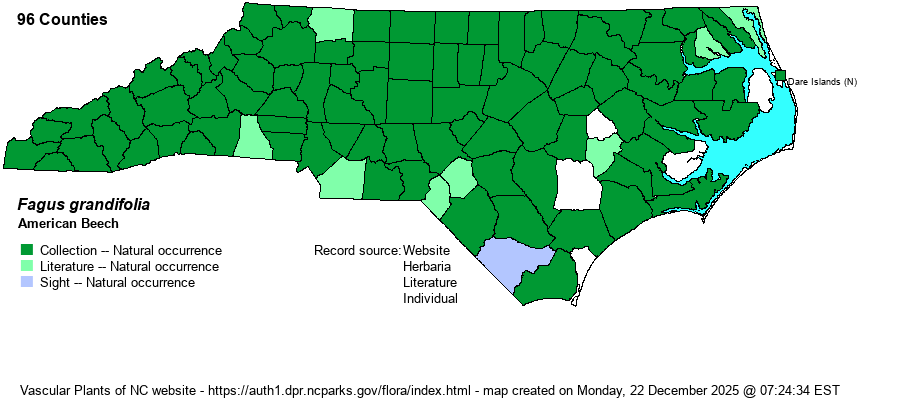| Author | Ehrhart | |
| Distribution | Throughout the state, but absent from some Coastal Plain counties.
This widespread Eastern species ranges from southeastern Canada south to northern FL and eastern TX. Over much of its range from MI, IN, and MS eastward, it is found in essentially every county.
| |
| Abundance | Common and easily found over nearly all of the state, likely less numerous in some far eastern counties. Absent, however, in the Sandhills proper, except where brownwater of the Cape Fear backs up into Little River. Can be the dominant tree, almost to the exclusion of other trees, on some high and exposed ridges in the Mountains (e.g., “beech gap forests”). | |
| Habitat | This is a species of a variety of mesic to rich forests. It is most numerous on mesic slopes and bluffs, where it can be the dominant tree in the Mesic Mixed Hardwood Forest natural community. It also grows in bottomlands, on natural levees, in cove forests, in fairly dry upland forests and flats, and especially on high elevation ridgetops. However, it is scarce over strongly circumneutral/basic soils, such as in Basic Mesic Forests. |
| Phenology | Flowers from March to May, and fruits from September to October. | |
| Identification | This is such a familiar and distinctive species that it needs little introduction or description. It is a medium to tall deciduous tree, typically to 80-90 feet tall, with a smooth pale gray trunk that is often carved into by “vandals”. The end buds are quite long, pointed, and sharp to the touch. The alternate, elliptical leaves are shallowly toothed, have many parallel veins, and average 3-4 inches long. Though the leaves turn bronzy-brown in fall, many of them remain on the branches all winter, making a Beech tree easy to spot in an otherwise barren and leafless deciduous forest. The fruit are spiny “husks”, about 3/4-inch long. | |
| Taxonomic Comments | A few references list varieties of this tree. Weakley (2018) lists the nominate variety -– F. grandifolia var. grandifolia –- as the one found in the state in the higher elevations (over 4500 feet) such as on high mountaintops and gaps, where it often grows in stunted and clonal form. The other variety -– var. caroliniana -– is statewide but occurs mainly below 3500 feet in elevation.
| |
| Other Common Name(s) | Beech, North American Beech | |
| State Rank | S5 | |
| Global Rank | G5 | |
| State Status | | |
| US Status | | |
| USACE-agcp | FACU link |
| USACE-emp | FACU link |

